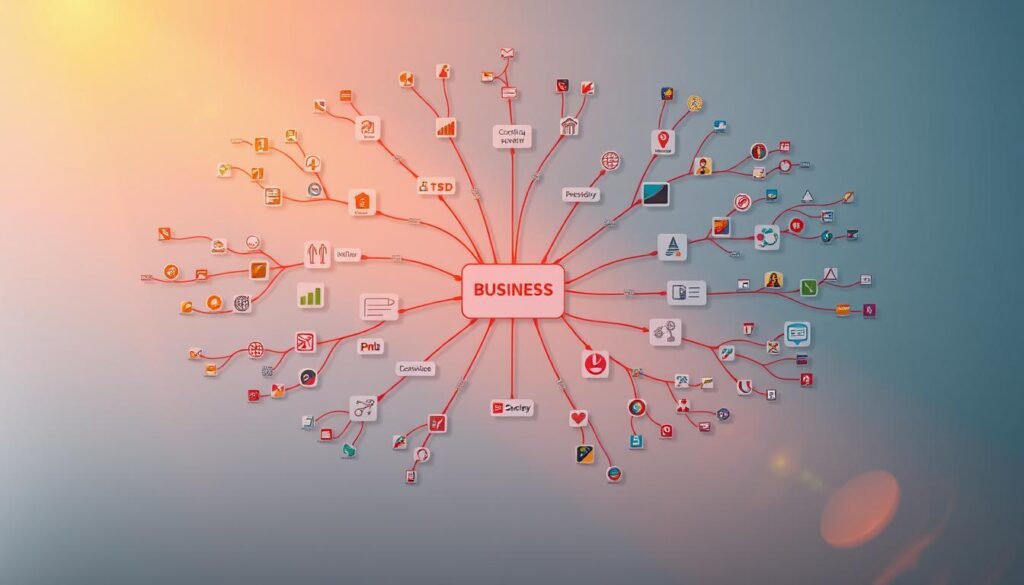Ever feel overwhelmed by complex projects or scattered ideas? What if one software could organize your thoughts, plans, and tasks visually—helping you work smarter, not harder?
MindManager stands out as a premier mind mapping software, trusted by over 4 million professionals worldwide. It transforms chaotic workflows into clear, actionable plans. Major companies like Boeing and Microsoft rely on it for project management and brainstorming.
Since 1994, this tool has evolved into a powerful solution for organizing knowledge and streamlining projects. Unlike basic mind mapping tools, it integrates with Microsoft 365, offering advanced features for businesses. Recent updates in 2021 further enhance its capabilities.
Key Takeaways
- Trusted by Fortune 500 companies for over 27 years
- Transforms ideas into structured workflows visually
- Seamlessly integrates with Microsoft 365 ecosystem
- Recent updates improve functionality for modern teams
- More powerful than basic mind mapping alternatives
What Is MindManager?
From medical recovery to global adoption, this tool has a unique story. It’s a mind mapping powerhouse that turns ideas into structured workflows. Over 4 million users rely on it across 200+ countries.
A Brief History of MindManager
Born in 1994 as “MindMan,” it started as a therapeutic project during creator Mike Jetter’s leukemia recovery. The tool evolved from simple maps to an enterprise platform.
Key milestones include the Mac version (2006), mobile apps (2011), and SharePoint integration (2014). Corel acquired it in 2016, expanding its reach. Today, it’s a staple for Fortune 500 teams.

Who Uses MindManager?
Enterprises dominate usage (58%), with tech (32%) and education (25%) leading industries. Governments like the US DoD and EU Parliament leverage it for strategic planning.
Academia thrives on it too—MIT and Stanford use it for research organization. Whether for brainstorming or complex information mapping, it adapts to diverse needs.
Key Features of MindManager
Effective project management starts with the right tools—here’s what sets this solution apart. It combines visual planning with robust workflows to simplify complex tasks.
Visualize Your Ideas with Mind Maps
Transform scattered thoughts into structured plans. The software supports mind maps with up to 20,000 branches per map, using colors and icons for clarity.
Conditional formatting automatically adjusts visuals based on rules. Combine timelines, flowcharts, and org charts into multi-hierarchy maps for deeper insights.
Streamline Project Management
Track progress with Gantt charts that link task dependencies. Built-in dashboards show resource allocation, while embedded Excel sheets monitor budgets.
Prebuilt templates—like SWOT analysis or sprint planning—save hours of setup. Automated reports update stakeholders without manual work.
Enhance Team Collaboration
Teams edit maps simultaneously with version control. MS Teams integration lets users brainstorm in-app, while cross-platform sync keeps everyone aligned.
Present ideas smoothly with slide transitions. Advanced filters use tags to highlight critical tasks, making meetings more productive.
Why Choose MindManager?
Looking for a smarter way to structure ideas and workflows? This tool combines cutting-edge brainstorming features with deep software integrations, making it a top choice for teams.
Unique Tools for Brainstorming and Planning
An AI-powered wizard suggests connections between concepts, speeding up creative sessions. Virtual sticky notes simulate whiteboarding, while one-click exports turn maps into PowerPoint decks.
For data-driven planning, bi-directional Excel sync keeps numbers updated. Embed Visio diagrams or PDFs with hyperlinks intact—no more manual adjustments.
Integration with Microsoft Office and Other Tools
Sync tasks with Outlook or embed SharePoint files directly into maps. Teams channels auto-update with changes, and Power BI visualizations link to live data.
Zapier connects 2,000+ apps, from Salesforce to custom APIs. Whether for CRM workflows or Agile sprints, it’s a hub for solutions.
MindManager for Different Use Cases
Different teams need different tools to maximize productivity—here’s how MindManager adapts. Its flexible features cater to executives, creatives, and everyone in between. A Forrester study found it cuts meeting documentation time by 67% and reduces project overruns by 41%.
For Business Professionals
Executives use scenario modeling to test strategies before implementation. Consultants map client journeys, while HR teams track onboarding progress visually. The tool turns complex business plans into clear, actionable steps.
For Project Managers
Gantt charts reveal critical paths, and dashboards highlight resource gaps. Teams sync tasks with Jira or SharePoint, avoiding missed deadlines. Real-time updates keep projects on track without endless emails.
For Creative Teams
Marketers plot campaign timelines with asset dependencies. Developers brainstorm sprints using drag-and-drop interfaces. The AI connection tool sparks ideas faster than traditional whiteboards.
MindManager Pricing and Plans
Flexible pricing plans make this product accessible for different team sizes. Whether you’re a solo user or a large organization, there’s a tier to match your needs.
Standard vs. Enterprise Versions
The Standard plan costs $349 per user for a perpetual license. It includes core features like mind maps, Gantt charts, and Microsoft 365 integration.
MindManager Enterprise offers custom pricing with advanced tools. It adds single sign-on (SSO), audit logs, and priority support. Volume discounts apply for teams of 10+.
Free Trial and Subscription Options
Test the free trial for 30 days with full features. No credit card is required, making it risk-free to evaluate.
Subscription options include cloud or on-premise deployment. EDU and government discounts save up to 40%. Maintenance plans cost 20% annually for updates.
How MindManager Compares to Other Tools
Not all mapping tools are created equal—here’s how top options stack up. A Capterra study shows 78% of users prefer MindManager for complex projects, but simpler tools like Lucidchart excel in basic diagramming.
MindManager vs. XMind
XMind offers intuitive mind maps but lacks advanced project features. MindManager’s Gantt charts and real-time collaboration outperform XMind’s comment-only teamwork mode.
Integration depth differs too. MindManager syncs with Office 365, while XMind leans on Google Workspace. For enterprises, MindManager’s audit logs and SSO provide stronger security.
MindManager vs. Lucidchart
Lucidchart wins for drag-and-drop simplicity but falls short for multi-layered planning. MindManager’s template library (500+ options) and API capabilities cater to scalable workflows.
Mobile functionality is another divider. MindManager’s iOS/Android apps support full editing, whereas Lucidchart limits mobile users to viewing mode.
Pros and Cons of MindManager
Every software has strengths and weaknesses—here’s an honest look at what makes this solution stand out. Whether you need an excellent tool for brainstorming or complex project tracking, understanding its trade-offs helps you decide.
Why Teams Love This Solution
Users praise its all-in-one visual workspace. It merges mind maps, Gantt charts, and dashboards into a single platform. No more switching between tools.
Enterprise-grade security features like SSO and audit logs protect sensitive data. Custom reports save hours, while cross-department use cases—from HR to engineering—prove its flexibility.
Challenges to Consider
The interface has a learning curve for new users. Advanced features like conditional formatting require training. Smaller teams may find the cost prohibitive compared to basic alternatives.
Offline mode lacks real-time sync, and mobile editing is slower than desktop. However, continuous updates address these gaps annually.
Alternatives to MindManager
Exploring other options? Several powerful alternatives offer unique features for different needs. While MindManager excels in complex project visualization, some teams may prefer specialized or simplified mapping software.
Top Mind Mapping Software Alternatives
Remote teams often choose Miro for its collaborative whiteboards. Agile developers favor ClickUp for sprint planning integration. FreeMind remains popular among students for its zero-cost structure.
Design-focused teams leverage Miro’s templates, while Mac users prefer MindNode’s native interface. Enterprises needing scalability opt for Lucidscale, and open-source advocates select XMind.
When to Consider Another Tool
Basic note-takers might find Obsidian sufficient. Those needing AI suggestions could test Ayoa. Flowchart specialists often switch to Draw.io for diagram precision.
Evaluate your team’s size, budget, and workflow complexity. The right mind mapping tool balances features with usability for your specific projects.
Conclusion
MindManager delivers enterprise-grade capabilities, transforming complex projects into structured workflows. Its advanced features save time and boost productivity, making it a top choice for teams.
The software offers a strong ROI with tools like Gantt charts, real-time collaboration, and seamless Microsoft 365 integration. A free trial lets you test its full potential before committing.
As an industry leader, it continues to innovate, with AI-powered enhancements on the roadmap. For long-term efficiency, MindManager stands out among mind mapping solutions.
Ready to streamline your workflow? Try the free trial today and experience the difference firsthand.
FAQ
What is MindManager used for?
It helps users organize ideas, manage projects, and improve collaboration through visual mind maps. Businesses, project managers, and creative teams rely on it for brainstorming and planning.
Does MindManager integrate with Microsoft Office?
Yes. It seamlessly connects with Word, Excel, PowerPoint, and Outlook, making it easy to transfer data between applications.
Is there a free trial available?
Yes. A 30-day free trial lets users explore features before committing to a subscription.
How does MindManager compare to XMind?
While both offer mind mapping, MindManager excels in project management tools and team collaboration, whereas XMind focuses more on individual brainstorming.
What are the pricing options?
Plans include Standard for individuals and Enterprise for teams, with flexible subscription or one-time purchase options.
Can MindManager handle complex projects?
Absolutely. Features like Gantt charts, task assignments, and progress tracking make it ideal for detailed project planning.
Are templates included?
Yes. Pre-built templates help users quickly start maps for brainstorming, SWOT analysis, and more.
What industries benefit most from MindManager?
Education, marketing, IT, and consulting find it valuable for organizing ideas and streamlining workflows.









